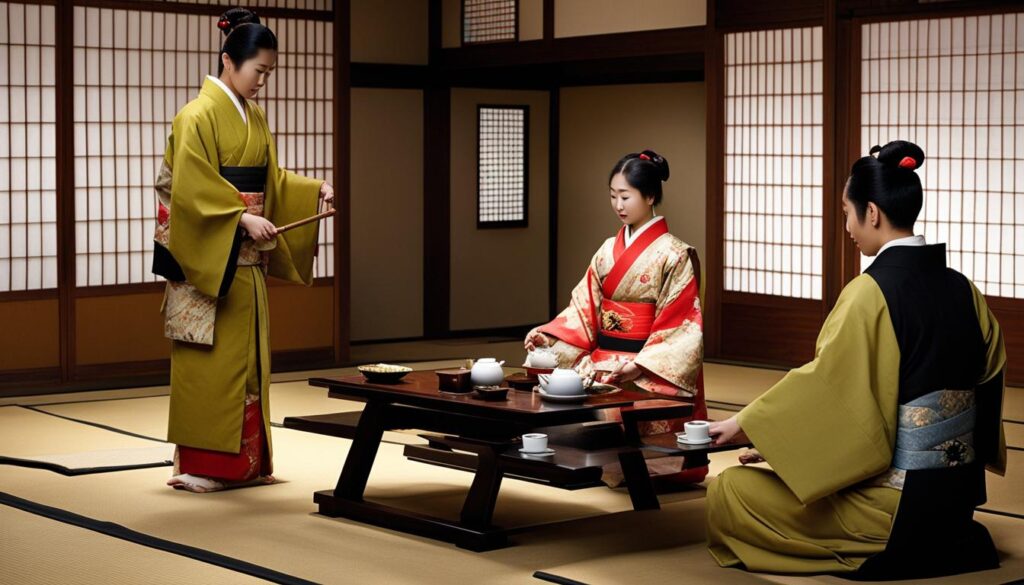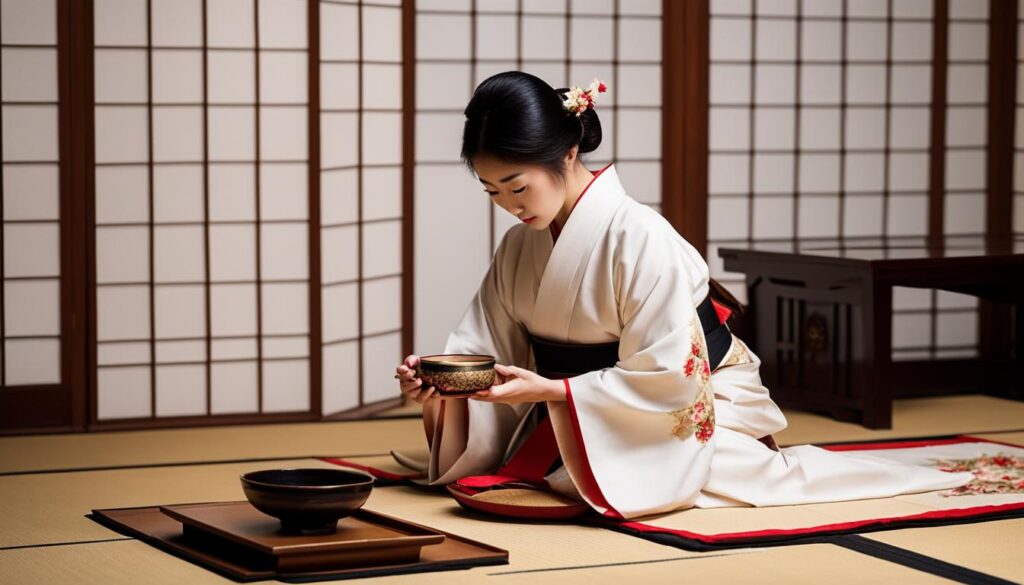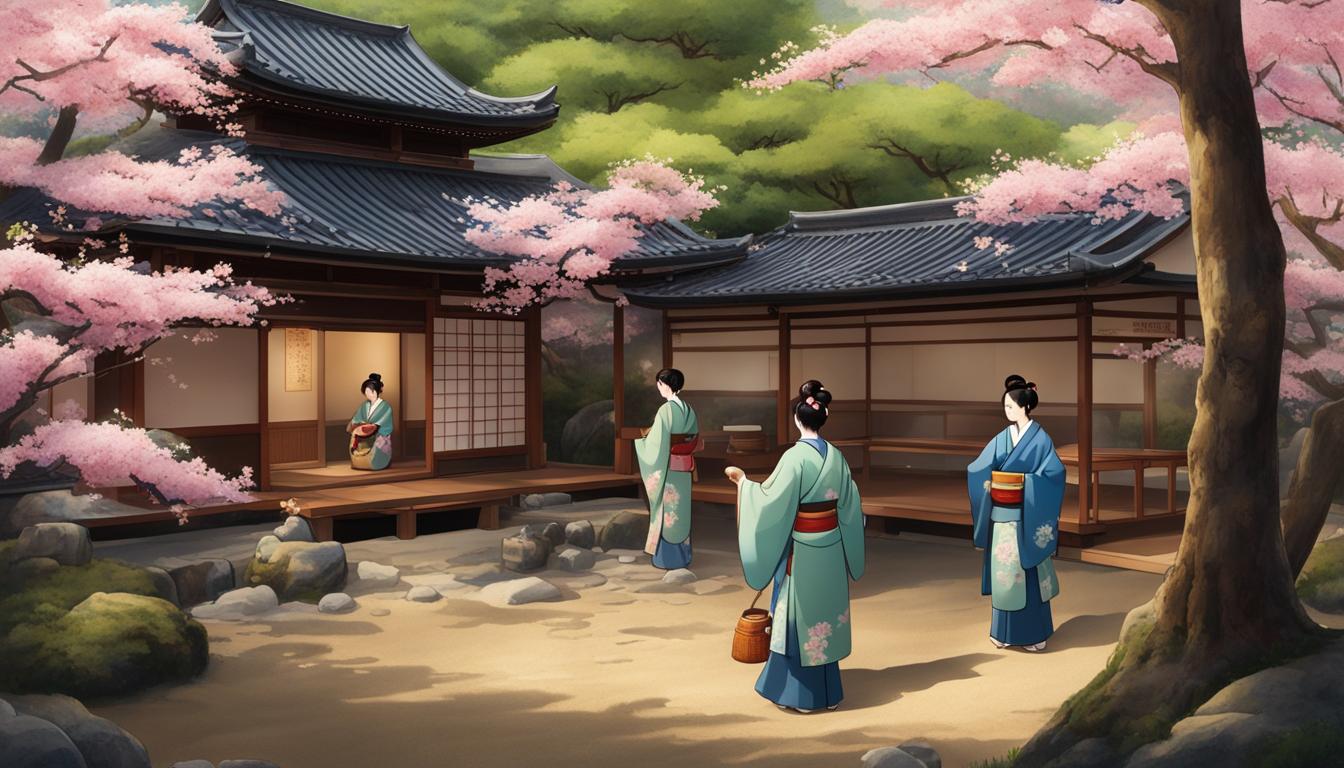Gather around, tea enthusiasts! Today, we embark on a journey through the captivating history and evolution of Japanese tea ceremonies. From its ancient origins in China to its refined practices in Japan, the art of the tea ceremony has stood the test of time, captivating hearts and minds with its harmony, respect, and tranquility.
Let’s dive deep into the rich history of Japanese tea ceremonies, exploring how this timeless tradition has shaped Japan’s cultural heritage and continues to enchant tea lovers around the world.
Key Takeaways:
- The Japanese tea ceremony has its roots in ancient China and was introduced to Japan by Buddhist monks in the 9th century.
- The development of traditional tea utensils played a significant role in shaping the tea ceremony, showcasing Japan’s dedication to simplicity and natural beauty.
- The tea ceremony underwent changes over time, influenced by different historical figures, social classes, and cultural developments.
- Japanese tea ceremonies can be categorized into formal and informal ceremonies, each with its own unique characteristics and purposes.
- Experiencing a Japanese tea ceremony in Kyoto is a must-do activity for visitors, offering a deep immersion into Japan’s rich history and cultural heritage.
The Origin and Development of the Tea Ceremony
The tea ceremony, known as “chado” or “sado” in Japanese, has a rich history that spans centuries. It originated in ancient China during the Tang Dynasty and was later introduced to Japan by Buddhist monks in the 9th century. Over time, the tea ceremony evolved into a highly formalized ritual, becoming an integral part of Japanese culture.
During the Song Dynasty in China, the tea ceremony gained popularity and underwent further development. It became a symbol of status and refinement, with elaborate rituals and strict etiquette. In Japan, the tea ceremony found favor with various historical figures, including Zen Buddhist monks and the samurai class. These influential individuals played a significant role in shaping the tea ceremony as it evolved through the ages.
“The tea ceremony is a way for us to connect with nature and find harmony within ourselves. It is a practice that teaches us patience, respect, and mindfulness.” – Tea Master Yamanaka
Throughout its history, the tea ceremony has been influenced by different social classes and cultural developments. While the formal tea ceremony, known as “chaji,” is reserved for special occasions and involves intricate rituals, there is also an informal version called “chakai.” The informal tea ceremony is shorter and less formal, allowing for a more relaxed atmosphere where the focus is on the experience of tea drinking rather than the elaborate rituals.
| Era | Historical Figures | Notable Developments |
|---|---|---|
| Kamakura Period (1185-1333) | Eisai, founder of the Rinzai school of Zen Buddhism | Tea was introduced as a medicinal beverage and used by Zen monks to aid in their meditation practice. |
| Muromachi Period (1333-1573) | Murata Juko, Sen no Rikyu | The tea ceremony became a highly ritualized practice, emphasizing simplicity, natural beauty, and the principles of wabi-sabi. |
| Edo Period (1603-1868) | Urasenke School, Omotesenke School, Mushakoji Senke | New schools of tea ceremony were established, each with their own unique approach and philosophy. |
The tea ceremony continues to be practiced and cherished to this day, preserving its authenticity and historical significance. It provides a glimpse into Japan’s cultural heritage, promoting harmony, respect, and tranquility.
Japanese Tea Ceremonies: Formal vs. Informal
Japanese tea ceremonies have transformed over time, adapting to changes in society and cultural influences. This evolution has led to the distinction between formal and informal ceremonies, each with its own unique characteristics and significance.
Ancient Practices and Cultural Evolution
The ancient practices of the tea ceremony have undergone significant changes throughout history. As Japanese society evolved, so did the tea ceremony, reflecting the values and customs of each era. From its origins as a formalized ritual practiced by Buddhist monks and the samurai class, the tea ceremony has become more accessible to the general public today.
In ancient times, the tea ceremony was highly exclusive and primarily reserved for the elite. However, as Japan underwent cultural and social changes, the tea ceremony evolved into a more inclusive practice. Today, people from all walks of life can experience the joy and tranquility of tea ceremonies.
Formal vs. Informal Ceremonies
The formal tea ceremony, known as Chaji, is a grand and elaborate affair. It is typically reserved for special occasions and involves inviting esteemed guests or senior tea masters. Chaji can last several hours and consists of various rituals and customs that showcase the rich cultural heritage of Japan.
On the other hand, the informal tea ceremony, called Chakai, is shorter and less formal. It provides a more relaxed and accessible way to experience Japanese tea culture. Chakai focuses more on the enjoyment of tea and the appreciation of the moment, rather than adhering to strict rituals.
| Formal Ceremony (Chaji) | Informal Ceremony (Chakai) |
|---|---|
| Lasts several hours | Shorter duration, usually under an hour |
| Elaborate rituals and customs | Relaxed atmosphere with fewer formalities |
| Reserved for special occasions | More accessible to the general public |
Both formal and informal tea ceremonies offer a unique opportunity to embrace Japanese culture and experience the art of tea. Whether participating in a grand Chaji or a more intimate Chakai, the tea ceremony allows individuals to immerse themselves in Japan’s ancient traditions and experience moments of tranquility amid the busyness of modern life.

Japanese Tea Ceremony Customs, Etiquette, and Attire
Attending a Japanese tea ceremony is an opportunity to immerse oneself in the rich traditions and cultural heritage of Japan. The tea ceremony follows a meticulously choreographed process with specific customs and etiquettes that have been passed down through generations. These customs and etiquettes play an essential role in creating an atmosphere of harmony, respect, and tranquility.
When participating in a tea ceremony, it is customary to dress appropriately. The attire for tea ceremonies is simple and understated, avoiding flashy elements or strong scents that may distract from the ceremony’s focus. This attire often includes wearing a kimono, a traditional Japanese garment symbolizing elegance and grace. By wearing a kimono, participants pay homage to the history and cultural significance of the tea ceremony.

The tea ceremony is a unique cultural experience that provides a moment of peace and an opportunity to appreciate the traditional values that have shaped this timeless tradition.
The tea ceremony itself is a careful and deliberate process. Participants sit in a formal kneeling position called Seiza, demonstrating their respect for the ceremony and their host. Before the actual tea service begins, attendees are served a light meal known as Kaiseki. This meal prepares the palate and enhances the overall sensory experience of the ceremony.
- Preparation of the tea involves different techniques depending on the type of tea being served. Thick tea, known as Koicha, is prepared by mixing a small amount of matcha powder with hot water and whisking it vigorously until it becomes a thick, smooth paste. Thin tea, known as Usucha, is prepared by gently whisking a larger amount of matcha powder with hot water to create a frothy and thin consistency.
- During the ceremony, traditional Japanese sweets called Wagashi are served. These sweets are carefully crafted to complement the flavors of the tea and add an element of sweetness to the experience.
- Participants engage in mindful tea drinking, savoring each sip and appreciating the artistry behind the tea-making process. The focus is not on consuming the tea quickly but on being present in the moment and fully experiencing the flavors and aroma.
Attending a Japanese tea ceremony is a unique cultural immersion that allows individuals to connect with the past while experiencing the beauty of the present. The customs, etiquette, and attire associated with the tea ceremony serve as a reminder of Japan’s rich history and the importance of preserving cultural heritage.
Experiencing a Japanese Tea Ceremony in Kyoto
When it comes to immersing yourself in the captivating world of Japanese tea ceremonies, Kyoto provides the perfect backdrop. This ancient city is renowned for its rich cultural heritage and offers numerous opportunities to partake in an authentic tea ceremony experience. Guided by licensed tea ceremony instructors, these dedicated venues in Kyoto provide a detailed insight into the intricacies of crafting matcha tea and serving traditional Japanese sweets.
As you immerse yourself in the serene atmosphere, you’ll witness the meticulous preparation and graceful gestures that are the essence of the tea ceremony. The tea masters will guide you through every step, from the proper way to whisk the matcha powder to the art of enjoying each sip. These experiences often come with additional materials and booklets, enhancing your understanding of the tea ceremony and its cultural significance.
For a truly immersive experience, consider donning a kimono, the traditional Japanese garment. Many tea ceremony venues offer kimono rental services, allowing you to fully embrace the spirit of the ceremony and transport yourself to a bygone era. The intricate patterns and vibrant colors of the kimono add an extra layer of authenticity to your tea ceremony experience.
Cultivating Mindfulness and Cultural Immersion
A Japanese tea ceremony in Kyoto is not just about savoring a cup of tea; it offers a profound journey of mindfulness and cultural immersion. As you engage in the carefully choreographed rituals, you’ll discover a sense of tranquility and harmony that transcends the mere act of tea preparation. Each movement and gesture is imbued with deep meaning, inviting you to be fully present in the moment and appreciate the beauty of simplicity.
Participating in a tea ceremony in Kyoto allows you to connect with Japan’s rich cultural heritage and gain a deeper understanding of its traditions. By stepping into the world of tea, you become part of a legacy that has spanned centuries, carrying with it the wisdom and grace of generations past. It’s a truly transformative experience that leaves a lasting impression on your soul.
Conclusion
The Japanese tea ceremony holds immense cultural significance, providing a spiritual journey into Japan’s traditions and values. It goes beyond a simple act of tea drinking, serving as a window into the country’s rich history and heritage. The ceremony’s emphasis on harmony, respect, purity, and tranquility creates a serene atmosphere that attracts visitors from around the world.
Participating in a Japanese tea ceremony is a unique cultural experience that allows one to step back in time and appreciate the timeless traditions that have shaped Japan. Whether you are a history enthusiast, a culture lover, or simply curious, immersing yourself in this ancient tradition is a must-do activity during your visit to Japan.
The tea ceremony offers a moment of peace and contemplation, allowing participants to connect with their inner selves and find tranquility amidst the chaos of the modern world. It is a journey that transcends time and space, offering a glimpse into the spiritual essence of Japanese culture.
By partaking in a Japanese tea ceremony, we embark on a spiritual journey, guided by the ancient customs and traditions that have been passed down through generations. It is a testament to the enduring value of traditional practices and a reminder of the importance of preserving our cultural heritage. So, don’t miss the chance to experience the magic and traditions of the Japanese tea ceremony and let it transport you to a world of tranquility and mindfulness.
FAQ
What is the historical evolution of Japanese tea ceremonies?
Japanese tea ceremonies have their roots in ancient China and were introduced to Japan in the 9th century. Over time, they evolved into a highly ritualized practice emphasizing harmony, respect, and tranquility.
How did the tea ceremony develop in Japan?
The tea ceremony gained popularity in Japan during the Song Dynasty in China and became an integral part of Japanese culture. It was practiced by Zen Buddhist monks and the samurai class, undergoing changes influenced by different social classes and cultural developments.
What are formal and informal tea ceremonies?
Formal tea ceremonies, known as Chaji, are longer and more elaborate affairs reserved for special occasions. Informal ceremonies, called Chakai, are shorter and less formal, offering a more accessible experience to the general public.
What are the customs and etiquettes associated with Japanese tea ceremonies?
Japanese tea ceremonies follow a meticulously choreographed process with specific customs and etiquettes. Participants sit in a formal kneeling position called Seiza, are served a light meal known as Kaiseki, and engage in the preparation and serving of thick and thin tea.
Where can I experience a Japanese tea ceremony in Kyoto?
Kyoto offers numerous opportunities to experience an authentic Japanese tea ceremony. There are dedicated venues guided by licensed tea ceremony instructors that provide a detailed insight into the intricacies of crafting matcha tea and serving traditional Japanese sweets.





